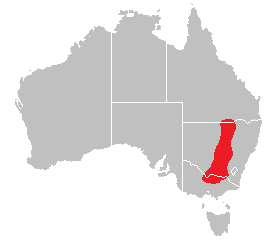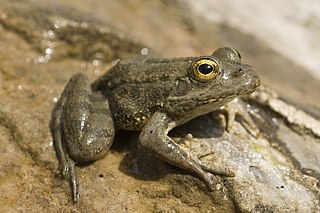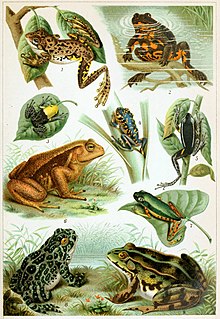
The Chuxiong fire-bellied newt is a species of salamander in the family Salamandridae that is endemic to China where it is only found in Guizhou and Yunnan. It also occurs in Kunming Lake.
Rhinella diptycha is a species of toad in the family Bufonidae that is found in Paraguay and possibly Brazil. Its natural habitats are dry savanna, freshwater marshes, and intermittent freshwater marshes. It is threatened by habitat loss.
Melanophryniscus pachyrhynus is a species of toad in the family Bufonidae. It is known from São Lourenço do Sul in southern Brazil and from Uruguay. Populations in Uruguay were until recently considered a different species and assessed as being vulnerable.
Melanophryniscus simplex is a species of toads in the family Bufonidae.
The Cooloola sedge frog or Cooloola tree frog is a species of frog in the family Hylidae. It is endemic to Australia. Its natural habitats are swamps, freshwater lakes, intermittent freshwater lakes, freshwater marshes, intermittent freshwater marshes, and coastal freshwater lagoons. It is threatened by habitat loss. Cooloola Tree Frogs only live in Australia and their lack of distribution adds to their endangerment. They mostly feed on bugs in their area; flies, spiders, moths, etc. Their green skin helps camouflage them because of their very green and wet habitat.
The buzzing tree frog is a species of frog in the family Hylidae. It is endemic to Australia. Its natural habitats are temperate forests, subtropical or tropical swamps, swamps, intermittent freshwater lakes, intermittent freshwater marshes, and urban areas.

Scinax acuminatus is a species of frog in the family Hylidae. It is found in Argentina, Bolivia, Brazil, Paraguay, and possibly Uruguay. Its natural habitats are moist savanna, subtropical or tropical moist shrubland, subtropical or tropical seasonally wet or flooded lowland grassland, freshwater lakes, intermittent freshwater lakes, freshwater marshes, intermittent freshwater marshes, pastureland, rural gardens, heavily degraded former forest, ponds, and canals and ditches. It breeds in bodies of water. It is threatened by eventual habitat loss, but the population is currently fairly stable, as it adapts fairly well to human encroachment and development.
Physalaemus santafecinus is a species of frog in the family Leptodactylidae. It is found in Argentina and possibly Paraguay. Its natural habitats are temperate grassland, intermittent freshwater lakes, intermittent freshwater marshes, and pastureland. It is threatened by habitat loss.

Physalaemus spiniger is a species of frog in the family Leptodactylidae. It is endemic to Brazil. Its natural habitats are subtropical or tropical moist lowland forests, subtropical or tropical moist shrubland, intermittent freshwater lakes, and intermittent freshwater marshes. It is threatened by habitat loss.
The sand frog is a species of frog in the family Myobatrachidae. It is endemic to South Western Australia. Its natural habitats are temperate forests, temperate shrubland, Mediterranean-type shrubby vegetation, shrub-dominated wetlands, swamps, intermittent freshwater lakes, and intermittent freshwater marshes.
The Glauert's froglet is a species of frog in the family Myobatrachidae. It is endemic to Australia. Its natural habitats are temperate forests, rivers, intermittent rivers, shrub-dominated wetlands, swamps, freshwater lakes, freshwater marshes, arable land, pastureland, plantations, rural gardens, water storage areas, ponds, open excavations, sewage treatment areas, and introduced vegetation. It is threatened by habitat loss.
The false western froglet is a species of frog in the family Myobatrachidae. It is endemic to Australia. Its natural habitats are temperate forests, rivers, intermittent rivers, shrub-dominated wetlands, swamps, freshwater lakes, intermittent freshwater lakes, freshwater marshes, intermittent freshwater marshes, freshwater springs, rocky areas, arable land, pastureland, plantations, water storage areas, ponds, open excavations, wastewater treatment areas, seasonally flooded agricultural land, and canals and ditches. It is threatened by habitat loss.
The remote froglet is a species of frog in the family Myobatrachidae. It is found in Australia, Indonesia, and Papua New Guinea. Its natural habitats are moist savanna, subtropical or tropical dry lowland grassland, subtropical or tropical seasonally wet or flooded lowland grassland, swamps, freshwater lakes, freshwater marshes, intermittent freshwater marshes, coastal freshwater lagoons, and canals and ditches.

The Sloane's froglet is a species of frog in the family Myobatrachidae. It is endemic to Australia. Its natural habitats are subtropical or tropical seasonally wet or flooded lowland grassland and intermittent freshwater marshes in and around the floodplains of the Murray-Darling Basin

The orange-crowned toadlet or western toadlet is a species of frog in the family Myobatrachidae. It is endemic to Australia. Its natural habitats are temperate shrubland, Mediterranean-type shrubby vegetation, intermittent rivers, intermittent freshwater lakes, freshwater marshes, intermittent freshwater marshes, and rocky areas.
The Central Asiatic frog or Asian frog is a species of frog in the family Ranidae, found in China, Kazakhstan, and Kyrgyzstan. Its natural habitats are temperate forests, temperate shrubland, temperate grassland, rivers, intermittent rivers, swamps, freshwater lakes, intermittent freshwater lakes, freshwater marshes, intermittent freshwater marshes, freshwater springs, inland deltas, arable land, pastureland, rural gardens, urban areas, water storage areas, ponds, aquaculture ponds, and irrigated land. It is not considered threatened by the IUCN.

The Karpathos frog is a species of frog in the family Ranidae. It is endemic to Greece.

The long-legged wood frog, Caucasus frog, or Uludağ frog is a species of frog in the family Ranidae found in Armenia, Azerbaijan, Georgia, Iran, Russia, Turkey, and Turkmenistan. Its natural habitats are boreal forests, temperate forests, temperate shrubland, subtropical or tropical dry shrubland, temperate grassland, rivers, intermittent rivers, swamps, freshwater lakes, intermittent freshwater lakes, freshwater marshes, intermittent freshwater marshes, freshwater springs, rocky areas, arable land, pastureland, plantations, rural gardens, urban areas, water storage areas, ponds, and introduced vegetation. It is not considered threatened by the IUCN.

The Hokkaidō frog or the Ezo brown frog is a species in the family Ranidae found in Hokkaidō, Japan, and Sakhalin. Its natural habitats are boreal forests, temperate forests, temperate shrubland, temperate grassland, rivers, swamps, intermittent freshwater lakes, freshwater marshes, intermittent freshwater marshes, arable land, ponds, and irrigated land.
Rana zhengi is a species of frog in the family Ranidae that is endemic to Sichuan, China.












